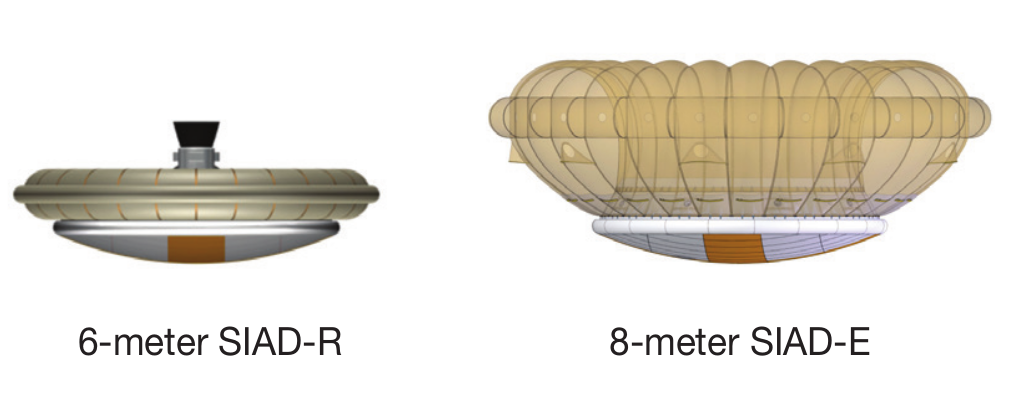NASA is testing an inflatable aerodynamic brake to land a man on Mars
The landing of the Curiosity rover was called “7 minutes of horror” - it was the most critical section of the entire Martian mission. First, the capsule with the device extinguished the speed of the atmosphere of Mars, then continued braking with the help of a parachute and, finally, gently sank to the surface with the help of a "sky crane" - a platform with rocket engines. The mass of the rover is a little less than a ton. Accurately landing a larger cargo on Mars is an even more difficult task than overcoming the “7 minutes of horror”. In a rarefied Martian atmosphere, parachutes are much less effective than on Earth, where even a tank can be grounded with their help. Therefore, NASA is developing an additional system of aerodynamic braking, which will allow landing a larger load on Mars with greater accuracy.

Now, within the framework of the Low Density Supersonic Decelerator or LDSD program, development is going on in three directions. One of them is a giant 33-meter parachute of a usual design. About his trialsrecently wrote on Habré. Two other devices, called Supersonic Inflatable Aerodynamic Decelerators (SIADs), are much more unusual. They are an inflatable "skirt", which significantly increases the aerodynamic drag of the descent vehicle. The first option has a diameter of 6 meters and is inflated using a gas cylinder. It is designed to land autonomous devices like Curiosity. The second option, with a diameter of 8 meters, is inflated by a flow of incoming air and is designed for heavier loads, including even landing vehicles with people on board. Both versions of the inflatable brake begin to work at a speed of 3.5 sound speeds and slow the device to 2 sound speeds when it is already safe to use a parachute.
Using the new landing system, you can increase the maximum weight of the launched cargo from the current 1.5 to 3 tons, improve the accuracy of landing from 10 to 3 km and significantly expand the geography, or rather the areography of places of possible landing, since it will be possible to land on platforms located at 2 - 3 kilometers higher - before they were inaccessible due to the fact that when landing at an elevated height the atmosphere was not enough for braking.

Field tests of inflatable braking systems will be held in 2014-2015 in Hawaii according to a rather interesting scheme. The descent vehicle will be raised to a height of 37 kilometers using a helium balloon. Then, with the help of rocket engines, it will be thrown higher - up to 55 km and accelerated to supersonic speeds, after which an air brake will come into effect, and then a parachute. Since 2012, SIAD has been tested in a wind tunnel and on a rocket rail platform, known to many on the television show "Legend Destroyers":


Now, within the framework of the Low Density Supersonic Decelerator or LDSD program, development is going on in three directions. One of them is a giant 33-meter parachute of a usual design. About his trialsrecently wrote on Habré. Two other devices, called Supersonic Inflatable Aerodynamic Decelerators (SIADs), are much more unusual. They are an inflatable "skirt", which significantly increases the aerodynamic drag of the descent vehicle. The first option has a diameter of 6 meters and is inflated using a gas cylinder. It is designed to land autonomous devices like Curiosity. The second option, with a diameter of 8 meters, is inflated by a flow of incoming air and is designed for heavier loads, including even landing vehicles with people on board. Both versions of the inflatable brake begin to work at a speed of 3.5 sound speeds and slow the device to 2 sound speeds when it is already safe to use a parachute.
Using the new landing system, you can increase the maximum weight of the launched cargo from the current 1.5 to 3 tons, improve the accuracy of landing from 10 to 3 km and significantly expand the geography, or rather the areography of places of possible landing, since it will be possible to land on platforms located at 2 - 3 kilometers higher - before they were inaccessible due to the fact that when landing at an elevated height the atmosphere was not enough for braking.

Field tests of inflatable braking systems will be held in 2014-2015 in Hawaii according to a rather interesting scheme. The descent vehicle will be raised to a height of 37 kilometers using a helium balloon. Then, with the help of rocket engines, it will be thrown higher - up to 55 km and accelerated to supersonic speeds, after which an air brake will come into effect, and then a parachute. Since 2012, SIAD has been tested in a wind tunnel and on a rocket rail platform, known to many on the television show "Legend Destroyers":

